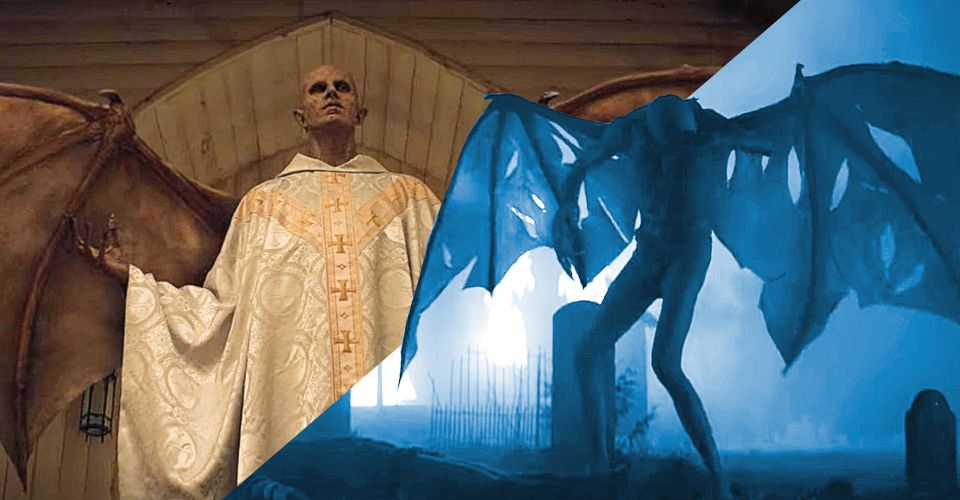Midnight Mass: The Vampire’s Ambiguous Death Is A Problem

The end of Mike Flanagan’s Midnight Mass leaves the death of its vampiric angel ambiguous — and that’s a problem. The mini-series ended with the climactic burning of Crockett Island and the deaths of almost all of its citizens. However, the fate of the angel responsible for the island’s downfall is left up in the air, giving viewers only a hint at whether it’s dead or alive. Here’s why the vampire’s open-ended fate creates an issue for Midnight Mass.
As the vampire’s Midnight Mass plan came to fruition, the citizens of Crockett Island were charmed with promises of eternal youth and perfect health. Though a large portion of the congregation chose to sacrifice their humanity for the blessing of the “angel,” a small band of heroes sacrificed their lives in order to keep the vampire and its new minions from leaving Crockett Island and infecting the rest of the world. Every building on the island was burnt to the ground to eliminate any shelter from the deadly sunlight, and as she lay dying, Erin sliced the wings of the vampiric beast to prevent it from reaching safety before sunrise. As Warren and Leeza, Crockett Island’s only survivors, watched their home burn to the ground, Leeza realized that the blessings the vampire bestowed upon her had disappeared, indicating the death of Midnight Mass‘ vampire.
However, the vampire’s fate may not be as clear as Midnight Mass‘ ending makes it appear. In an interview from the time of release, creator Mike Flanagan explained that Leeza losing her ability to walk was never intended to imply The Angel’s death. “We didn’t want it to confirm about The Angel, in that way you can never kill fanaticism,” Flanagan explained, “it’ll always kind of come back.” (via The Wrap) Instead, the moment was meant to imply that The Angel/vampire’s blood had worked its way out of Leeza’s body, leaving her fully human once more. But this interpretation of the scene undercuts the deeper meaning the moment carried. Instead of being a significant sign of hope and relief for the nightmare’s sole survivors, it turns it into a scene of vague ambiguity that fails to provide a satisfying conclusion to the horror series.

According to Flanagan, however, there is meaning in the ambiguity itself. In another interview, Flanagan expanded further on what The Angel represents. As Leeza and Warren watched The Angel disappear, Flanagan reads it as them watching the horrors that the generation before them had left behind. “I wish it wasn’t so on fire as it is right now, but it really is, and we’re never gonna be able to explain that to them,” Flanagan explained. “We’re never gonna be able to explain adequately to our children what happened to the planet that they inherited and why their parents’ generation treated each other the way that it did.” (via Collider). This interpretation of Midnight Mass‘ Angel/vampire is thought-provoking, and definitely fits more neatly with the series’ criticism of the corruption of religion. Yet, this non-answer about the vampire’s fate still somewhat undermines the meaning the scene once held and makes the sacrifices the citizens made feel pointless.
However, Flanagan encourages alternate readings of Midnight Mass. After explaining what he believes to be the true meaning behind the series’ final scene, Flanagan reassured that he loved the read viewers got out of it. While ambiguity can be a problem, it also allows room for viewers to make their own interpretations of a series —and with a show like Midnight Mass, which is filled with symbolism and heavy meaning, there is plenty of room for viewers to take away whatever meaning they prefer.
About The Author

















